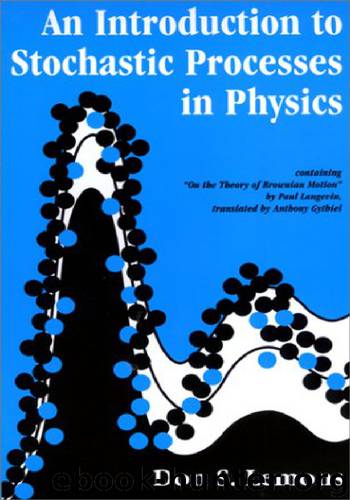An Introduction to Stochastic Processes in Physics by Don S. Lemons

Author:Don S. Lemons [Lemons, Don S.]
Language: eng
Format: epub
Published: 2011-02-19T05:00:00+00:00
P R O B L E M S
4 9
we find that p( x, t) solves the classical diffusion equation
∂ p( x, t)
δ2 ∂2
=
p( x, t) . (
∂
6.5.5)
t
2
∂ x 2
Equation (6.5.5) is mathematically equivalent to the stochastic dynamical equation (6.3.1). The latter equation governs the random variable X ( t), while the former governs its probability density p( x, t).
Deducing the diffusion equation (6.5.5) from its solution (6.5.1) reverses the usual order in modeling and problem solving. A more physically motivated derivation of (6.5.5) often starts with the observation, called Fick’s law, that a gradient in the probability density ∂ p/∂ x drives a probability density flux J
so that
∂ p
J = − D
.
(
∂
6.5.6)
x
where the proportionality constant D is called the diffusion constant. Fick’s law, like F = ma and V = IR, both defines a quantity (diffusion constant, mass, or resistance) and states a relation between variables. The diffusion constant is positive definite, that is, D ≥ 0, because a gradient always drives an oppositely directed flux in an effort to diminish the gradient. Combining Fick’s law and the one-dimensional conservation or continuity equation
∂ p
∂
+ J =
∂
0
(6.5.7)
t
∂ x
yields the diffusion equation (6.5.5) with D replacing δ2/2.
In his famous 1905 paper on Brownian motion, Albert Einstein (1879–1955) constructed the diffusion equation in yet another way—directly from the continuity and Markov properties of Brownian motion. Our approach, in section 6.3, to the mathematically equivalent result X ( t) − X (0) = N t (0, 2 Dt) has been 0
via the algebra of random variables. We use the phrase Einstein’s Brownian motion to denote both these configuration-space descriptions (involving only position x or X ) of Brownian motion. In chapters 7 and 8, we will explore their relationship to Newton’s Second Law and possible velocity-space descriptions (involving velocity v or V as well as position).
Problems
6.1. Autocorrelated Process.
Let X ( t) and X ( t ) be the instantaneous random position of a Brownian particle at times for which t ≤ t.
a. Find cov{ X ( t), X ( t )}.
b. Find cor{ X ( t), X ( t )}.
c. Evaluate cor{ X ( t), X ( t )} in the limits t / t → 0 and t / t → 1.
(Hint: Refer to the solution [6.3.6] and to self-consistency [6.2.7]. Also compare with Problem 3.4, Autocorrelation.)
Download
This site does not store any files on its server. We only index and link to content provided by other sites. Please contact the content providers to delete copyright contents if any and email us, we'll remove relevant links or contents immediately.
The Complete Stick Figure Physics Tutorials by Allen Sarah(7134)
Secrets of Antigravity Propulsion: Tesla, UFOs, and Classified Aerospace Technology by Ph.D. Paul A. Laviolette(4972)
Thing Explainer by Randall Munroe(3782)
The River of Consciousness by Oliver Sacks(3409)
The Order of Time by Carlo Rovelli(3071)
How To by Randall Munroe(2911)
I Live in the Future & Here's How It Works by Nick Bilton(2838)
A Brief History of Time by Stephen Hawking(2817)
What If?: Serious Scientific Answers to Absurd Hypothetical Questions by Randall Munroe(2542)
The Great Unknown by Marcus du Sautoy(2532)
Midnight in Chernobyl by Adam Higginbotham(2384)
Blockchain: Ultimate Step By Step Guide To Understanding Blockchain Technology, Bitcoin Creation, and the future of Money (Novice to Expert) by Keizer Söze(2377)
Networks: An Introduction by Newman Mark(2264)
The Meaning of it All by Richard Feynman(2213)
Easy Electronics by Charles Platt(2204)
The Tao of Physics by Fritjof Capra(2162)
Midnight in Chernobyl: The Untold Story of the World's Greatest Nuclear Disaster by Adam Higginbotham(2074)
When by Daniel H Pink(2019)
Introducing Relativity by Bruce Bassett(2015)
